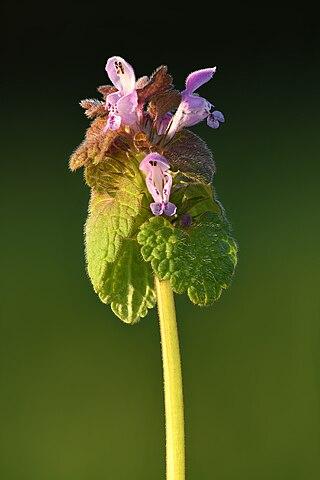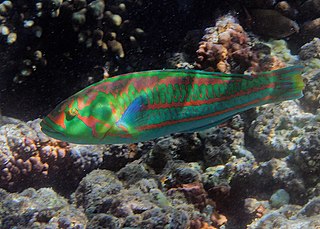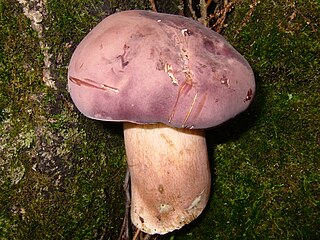Related Research Articles

Lamium purpureum, known as red dead-nettle, purple dead-nettle, or purple archangel, is an annual herbaceous flowering plant native to Europe and Asia.

Theobroma is a genus of flowering plants in the mallow family, Malvaceae, that is sometimes classified as a member of Sterculiaceae. It contains roughly 20 species of small understory trees native to the tropical forests of Central and South America.

Stereum is the type genus of the Stereaceae family of fungi, in the Russulales order. Until recently, the genus was classified in the Corticiaceae family, of the Corticiales order. However, it was given its own family as a result of the split-up of the Corticiales. Common names for species of this genus include leaf fungus, wax fungus, and shelf fungus. Fungi having a shape similar to a Stereum are said to have a stereoid shape. Stereum contains 27 species that have a widespread distribution.

Silver leaf is a fungal disease of trees caused by the fungus plant pathogen Chondrostereum purpureum. It attacks most species of the rose family Rosaceae, particularly the genus Prunus. The disease is progressive and often fatal. The common name is taken from the progressive silvering of leaves on affected branches. It is spread by airborne spores landing on freshly exposed sapwood. For this reason cherries and plums are pruned in summer, when spores are least likely to be present and when disease is visible. Silver Leaf can also happen on poming fruits like apples and pears. Plums are especially vulnerable.

Helicobasidium purpureum is a fungal plant pathogen which causes violet root rot in a number of susceptible plant hosts. It is synonymous with Helicobasidium brebissonii (Desm.) Donk. It is the teleomorph of Tuberculina persicina which is its mycoparasitic anamorph.

Eutrochium purpureum, commonly known as purple Joe-Pye weed or sweetscented joe pye weed, is an herbaceous perennial plant in the family Asteraceae. It is native to eastern and central North America, from Ontario east to New Hampshire and south as far as Florida, Louisiana, and Oklahoma.
Purpureum, purple in Latin, may refer to:

Chondrostereum is a genus of fungi in the family Cyphellaceae. The type species, Chondrostereum purpureum, causes the disease called silver leaf.
Dictyostelium purpureum is a species of Dictyostelium.

Calostemma is a small genus of herbaceous, perennial and bulbous plants in the Amaryllis family, commonly known as Wilcannia Lily. It consists of three species endemic to Australia, where they are distributed in arid regions with summer precipitation.

The surge wrasse, also known as the green-blocked wrasse, purple wrasse or red and green wrasse, is a species of wrasse native to the southeast Atlantic Ocean through the Indian and Pacific Oceans, where it inhabits reefs and rocky coastlines in areas of heavy wave action at depths from the surface to 10 m (33 ft). This species is of minor importance to local commercial fisheries, is popular as a game fish, and can be found in the aquarium trade.

Colchicum cilicicum, the Tenore autumn crocus, is a species of flowering plant in the Colchicaceae family. A bulbous perennial, it bears deep rose-lilac flowers in late summer, with barely any chequered pattern on the petals (tessellation). It has a very noticeable white stripe down the centre of each petal, which gives it a star-like appearance at the base. The flowers tend to stand up to weather better than other colchicum blooms. The flowers appear before the strap-like leaves, giving this and other colchicum species the common name “naked lady”. Although colchicums are called “autumn crocuses” they belong to a different family than true crocuses. There are in fact autumn-flowering species of crocus such as Crocus sativus, which is the source of the spice saffron. Colchicum cilicicum, by contrast, is toxic if eaten.
C. purpureum may refer to:
L. purpureum may refer to:
Calliostoma purpureum is a species of sea snail, a marine gastropod mollusk in the family Calliostomatidae.
Dipodium purpureum is an orchid species that is native to Borneo. The species was formally described in 1910 by Dutch botanist Johannes Jacobus Smith.

Geranium purpureum, the little-robin, is a species of plant in the genus Geranium.
Compsosomatini is a tribe of longhorn beetles of the subfamily Lamiinae.

Xanthoconium purpureum is a species of bolete fungus in the genus Xanthoconium. It was described as new to science in 1962 by Wally Snell and Esther Dick in 1962. It is found in eastern North America, where it fruits under oak, sometimes in oak-pine forests.

Morum is a genus of sea snails, marine gastropod mollusks in the subfamily Moruminae of the family Harpidae.
References
- ↑ Biolib.cz - Eusphaerium purpureum. Retrieved on 8 September 2014.